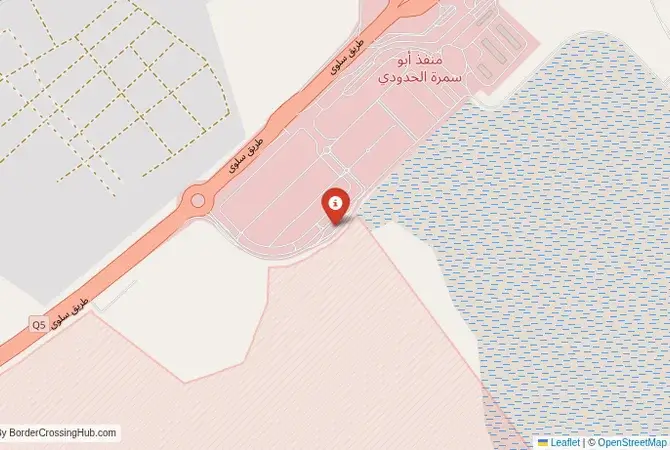
Approximate Border Location
Border Countries
- 🇸🇦Saudi Arabia
- 🇶🇦Qatar
Border Cities
- 🇸🇦Salwa
- 🇶🇦bu Samrah
Wait Times
30-60 min for vehicles
Operating Hours
Open 24 hours
Crossing Types
Vehicles, commercial
Border Type
Land crossing via road
Peak Times
Mornings (7-10 AM), weekends
Daily Crossings
~8000 travelers/vehicles
Currency Exchange
Available near Salwa (SAR, QAR)
Safety Information
Generally safe, traffic hazards
Languages Spoken
Arabic, English
Accessibility Features
Ramps, elevators
About Salwa & bu Samrah
A Word of Caution: Geopolitical Context
The Salwa-Abu Samra border crossing is the only land link between Saudi Arabia and Qatar. It is crucial to understand that this border’s operational status can be subject to the prevailing political climate in the region. The border was closed entirely for several years during a diplomatic rift and has since reopened. Before planning any travel, you must verify the current status of the border and any specific entry requirements through official government sources from both Saudi Arabia and Qatar. Do not rely on anecdotal evidence or outdated information.
The Salwa-Abu Samra Land Port
Your overland journey into Qatar from the west begins and ends at the Salwa land port in Saudi Arabia and the corresponding Abu Samra checkpoint in Qatar. This crossing carves a path through a flat, arid peninsula, connecting the wider Arabian Peninsula to Qatar. Following significant upgrades, particularly in the lead-up to the 2022 FIFA World Cup, the facilities at Abu Samra are now exceptionally modern and designed for high-capacity processing. The experience is one of navigating large, state-of-the-art facilities in a highly remote desert location. For travelers, it is the sole gateway to entering Qatar by road, making its smooth operation critical for regional transport and tourism.
A Frontier of Strategic Importance
The history of this border is less about ancient caravan routes and more about modern geopolitics. Its existence defines Qatar as a peninsula rather than an island and gives it a physical connection to its only neighbor. The diplomatic crisis that began in 2017, which saw the border closed, highlighted its immense strategic importance. The closure severed Qatar’s only land route for imports, forcing the country to rely on sea and air freight. Its reopening in 2021 was a major step in regional reconciliation. The subsequent multi-billion dollar renovation of the Abu Samra post by Qatar, transforming it into a facility capable of handling tens of thousands of people and vehicles per day, signals a clear intention to foster tourism and trade with its neighbor. The crossing is a barometer of regional relations and a vital economic link.
Before Crossing
Crossing borders gets messy sometimes, think political flare-ups or gates shutting fast. Good travel insurance is a must for handling doctor visits, trip disruptions, or security scares. Don’t get caught unprepared. To find a policy that’s got your back, check out reliable plans today for peace of mind.
The Crossing Procedure: Step-by-Step
The process involves clearing formalities at two separate, large-scale complexes. While the facilities are modern, the time required can vary from under an hour to several hours, especially during regional events or holidays.
Operating Hours: The border is open 24/7, but always verify this before travel.
Exiting Saudi Arabia (Salwa): The Saudi post at Salwa is a substantial facility. You’ll follow lanes for cars and proceed to passport control booths for your exit stamp. Afterwards, a customs check is required. As with other Saudi crossings, officials will check your vehicle and luggage before you are cleared to proceed into the no-man’s-land separating the two posts.
Entering Qatar (Abu Samra): The Abu Samra complex is impressively large and new. Upon arrival, you will be directed to specific lanes for different types of travelers (e.g., GCC nationals, expatriates, visitors).
1. Vehicle Insurance: Your first mandatory stop will be at the vehicle insurance offices. You must purchase temporary Qatari third-party insurance for your vehicle. This is a prerequisite for entry.
2. Immigration: Proceed to the immigration hall or drive-thru booths. You must have your visa situation sorted beforehand. Many nationalities can get a visa on arrival, but Qatar also uses the online “Hayya” platform, which may be required for entry, especially for those driving. Check the official Hayya portal for the latest requirements. Your passport will be stamped, and a photo may be taken.
3. Customs: The final step is a detailed customs inspection. Qatar has strict rules on the importation of certain goods, including alcohol and pork products, which are prohibited. Your vehicle and luggage will be X-rayed and possibly physically inspected before you are allowed to enter the country.
Route Conditions and Essential Preparation
The highways on both sides of the border are modern and well-maintained. The drive takes you through a stark but often beautiful desert landscape. Key preparations include ensuring your vehicle is in excellent condition, particularly the AC and tires. Fuel up before you reach the border, as facilities are limited at the crossing itself. The most critical piece of preparation is documentation. For your vehicle, if it is not in your name, an official letter of authorization (NOC) is non-negotiable. For yourself, you must research the current visa and entry platform requirements (like Hayya) on official Qatari government websites. Requirements can change with little notice. Having offline maps, plenty of water, and some snacks for potential delays is always a prudent measure.
Final Thoughts Before You Go
The Salwa-Abu Samra crossing is a modern and generally well-organized border, but it is subject to the unique political and logistical realities of the region. Double-checking the border’s status and all entry requirements is not just a recommendation; it is an essential first step in your planning. With the correct paperwork for both yourself and your vehicle, you can expect a systematic, if sometimes lengthy, process to enter the State of Qatar.
No reviews yet.
